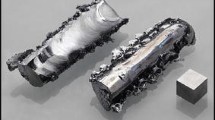Abstract
It is shown that these complexes can be formed between the reactants in redox reactions. Oxidizing and reducing agents are classified on the basis of charge-transfer capacity, which is defined by the integral for the overlap between the filled orbital of the reductant and the free one of the oxidant. Unfilled diffuse d-orbitals most readily give such complexes. Homogeneous catalysis of a redox reaction involves charge transfer in either direction between the catalyst (which has partly filled d-orbitals) and one of the reagents. The transfer is very much dependent on the orientation, so activators play a large part.
Similar content being viewed by others
Refferences
R. S. Mulliken, J. Am. Chem. Soc., 74, 811, 1952; J. Phys. Chem., 56, 801, 1952, Rec. Trav. Chem., 75, 845, 1956.
S. P. McGlynn, Chem. Revs., 58, 1113, 1958.
Author information
Authors and Affiliations
Rights and permissions
About this article
Cite this article
Yatsimirskii, K.B. Charge-transfer complexes in homogeneous catalysis. Theor Exp Chem 1, 221–222 (1965). https://doi.org/10.1007/BF01134323
Issue Date:
DOI: https://doi.org/10.1007/BF01134323




